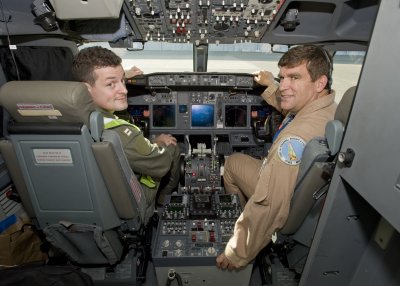
U.S. Navy pilot Lt. Roger Stanton (left) and Boeing test pilot Doug Benjamin sit in the P-8A Poseidon cockpit in preparation for flight. The aircraft’s Oct. 15 flight was the first with a Navy pilot at the controls and kicked off the formal flight test program. (Photo provided by The Boeing Company)
NAVAIR PATUXENT RIVER, Md. (Dec. 15, 2009) - When a new Navy aircraft takes to the skies it is always a proud moment for any aircraft program. For the actual pilot behind the controls, it is an even greater feeling.
Lt. Roger Stanton had the privilege of being the first Navy test pilot to fly the P-8A Poseidon in October.
“It felt awesome,” Stanton said. “The first time you fly a new airplane it’s just a great experience. This is what test pilots are trained to do, so getting this rare opportunity was really amazing.”
Stanton, along with Boeing pilot Doug Benjamin, flew the first Poseidon, designated T1, over the Puget Sound in Washington, kicking off the formal Navy flight test program.
“It was a good day - a really good day,” Stanton said. “All the training I received was great. We rehearsed the flight profile many times so we came into the flight very well prepared, but it was still fun.”
Stanton began T1 flight preparation in 2008 with Boeing 737 training in Seattle, consisting of classroom courses, computer-based training and a mixture of commercial 737 simulators as well as time in an actual 737 aircraft. He also spent approximately 250 hours in the Weapon System Integration Lab, located in Kent, Wash.
The WSIL is a non-motion based simulator designed to help the test team integrate aircraft and mission systems, as well as, test aircraft components.
“For the baseline P-8, it certainly flies like a 737,” he said. “They did a nice job of building the airplane. The interesting flying for the P-8 really will come when we have to emulate the P-3 mission – high bank angle, low altitude, autopilot integrated into our mission with missiles on the wings. It will get interesting.”
That type of flying will come later in the test program. T1 actually made three flights in October, prior to undergoing more instrumentation installation in the factory. The first flight was to check the airworthiness, or how well the modified 737 aircraft flies with all the test instrumentation.
The second two flights practiced instrument approaches with a visual restrictive device. Stanton said one of the things the Navy closely monitors is whether or not the pilots are capable of safely flying the plane if they can’t look out the window for visual reference.
Initial testing of T1 is being conducted in Seattle. It will transfer to Pax in early 2010, where flight and operational testing will be completed by the integrated test team (ITT).
The Poseidon ITT, comprised of Navy test squadrons—Air Test and Evaluation Squadron 20 and Air Test and Evaluation Squadron 1—and Boeing, will spend the next 36 months flying and evaluating three aircraft, designated T1, T2 and T3. The evaluation will include extensive mission systems testing, operational effectiveness and ability to carry out the anti-submarine warfare, anti-surface warfare and intelligence, surveillance and reconnaissance operations in accordance with Naval Air Systems Command requirements.
Stanton said the maritime patrol and reconnaissance community needs a new aircraft and needs it badly. He said the Fleet needs an airframe that’s capable of meeting the requirements set forth by the Navy and that support the maritime strategy.
“Our job here is to test that capability on the Poseidon,” he said. “As an operational P-3 pilot, I am fully aware of the challenges facing the [MPRA] community as they try and execute their high demand mission with a dwindling number of aging assets. Testing the P-8 and getting it to the [MPRA] community as soon as possible will help alleviate some of those challenges.”
Source: NAVAIR


